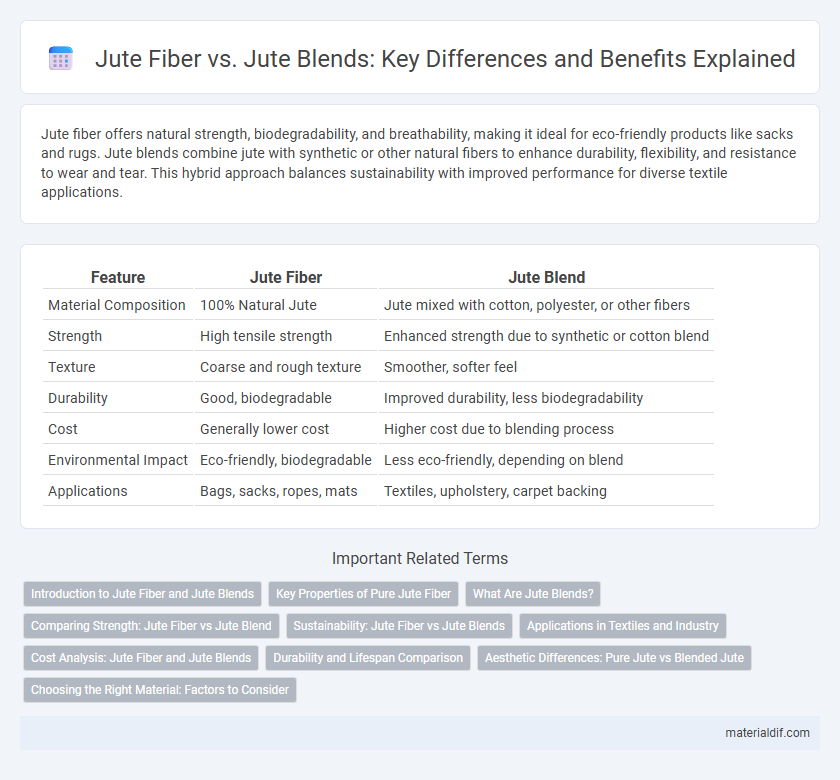Jute fiber offers natural strength, biodegradability, and breathability, making it ideal for eco-friendly products like sacks and rugs. Jute blends combine jute with synthetic or other natural fibers to enhance durability, flexibility, and resistance to wear and tear. This hybrid approach balances sustainability with improved performance for diverse textile applications.
Table of Comparison
| Feature | Jute Fiber | Jute Blend |
|---|---|---|
| Material Composition | 100% Natural Jute | Jute mixed with cotton, polyester, or other fibers |
| Strength | High tensile strength | Enhanced strength due to synthetic or cotton blend |
| Texture | Coarse and rough texture | Smoother, softer feel |
| Durability | Good, biodegradable | Improved durability, less biodegradability |
| Cost | Generally lower cost | Higher cost due to blending process |
| Environmental Impact | Eco-friendly, biodegradable | Less eco-friendly, depending on blend |
| Applications | Bags, sacks, ropes, mats | Textiles, upholstery, carpet backing |
Introduction to Jute Fiber and Jute Blends
Jute fiber, a natural vegetable fiber derived from the Corchorus plant, is renowned for its strength, durability, and biodegradability, making it ideal for eco-friendly products like sacks, ropes, and mats. Jute blends combine pure jute with synthetic or other natural fibers to enhance properties such as softness, flexibility, and resistance to wear, expanding their application in textiles and upholstery. These blends optimize jute's natural benefits while addressing limitations like brittleness and moisture retention, offering a versatile solution for sustainable fabric production.
Key Properties of Pure Jute Fiber
Pure jute fiber is characterized by its high tensile strength, natural biodegradability, and excellent breathability, making it ideal for eco-friendly textile applications. It possesses a coarse texture with moderate durability and inherent resistance to sunlight and moisture, enhancing its sustainability profile. Unlike jute blends, pure jute fiber maintains superior natural luster and dye absorption properties, which contribute to vibrant coloration and robust fabric quality.
What Are Jute Blends?
Jute blends refer to textiles made by combining jute fibers with other natural or synthetic fibers such as cotton, polyester, or hemp to enhance durability, texture, and versatility. These blends offer improved strength, reduced brittleness, and increased resistance to wear compared to pure jute fiber products. By mixing fibers, jute blends achieve better flexibility and a softer feel, making them suitable for a wider range of applications including home decor, upholstery, and fashion accessories.
Comparing Strength: Jute Fiber vs Jute Blend
Jute fiber is known for its natural tensile strength, making it highly durable for various industrial applications. Jute blends combine pure jute with synthetic fibers like polyester or cotton, enhancing overall strength and resistance to wear while maintaining eco-friendly properties. The blend typically offers improved flexibility and tensile strength compared to 100% jute fiber, making it suitable for more demanding uses such as upholstery and heavy-duty packaging.
Sustainability: Jute Fiber vs Jute Blends
Jute fiber is a highly sustainable, biodegradable, and renewable natural material with minimal environmental impact, making it an eco-friendly choice for textiles and packaging. Jute blends combine jute with synthetic or other natural fibers to improve durability and texture but may compromise biodegradability and increase the carbon footprint depending on the blend ratio. Choosing pure jute fiber ensures maximum sustainability benefits, including lower water usage and reduced chemical treatment compared to jute blends.
Applications in Textiles and Industry
Jute fiber is widely used in textiles for making sacks, bags, and carpets due to its natural strength, biodegradability, and cost-effectiveness, making it ideal for eco-friendly packaging and home furnishings. Jute blends, combining jute with synthetic fibers like polyester or cotton, enhance fabric durability, texture, and softness, expanding applications to upholstery, fashion garments, and geotextiles. Industrially, pure jute offers excellent tensile strength for agricultural and construction materials, while jute blends provide improved resistance to wear and weather, suited for composite materials and industrial textiles.
Cost Analysis: Jute Fiber and Jute Blends
Jute fiber offers a cost-effective raw material option with its natural abundance and low production expenses, making it ideal for budget-conscious applications. Jute blends combine jute with synthetic or other natural fibers, often increasing material costs but enhancing durability and versatility. The cost analysis reveals jute fiber as the more economical choice upfront, while jute blends may provide better long-term value through improved performance characteristics.
Durability and Lifespan Comparison
Jute fiber offers natural durability with moderate tensile strength, making it suitable for lightweight, eco-friendly products that degrade faster under harsh conditions. Jute blends, often combined with synthetic fibers like polyester, enhance durability and extend lifespan by improving resistance to abrasion, moisture, and UV exposure. The hybrid composition of jute blends results in longer-lasting materials ideal for heavy-duty applications compared to pure jute fiber.
Aesthetic Differences: Pure Jute vs Blended Jute
Pure jute fiber showcases a natural, coarse texture with a matte finish, offering a rustic and authentic aesthetic ideal for eco-friendly and artisanal products. Jute blend materials combine jute with synthetic or natural fibers, resulting in a smoother surface, enhanced color vibrancy, and increased durability while maintaining some organic appeal. Blended jute fabrics are often more versatile in design, providing a balance between traditional roughness and modern refinement for varied decorative and functional applications.
Choosing the Right Material: Factors to Consider
Jute fiber offers natural biodegradability, tensile strength, and breathability, making it ideal for eco-friendly packaging and textile applications. Jute blends, often combined with cotton or synthetic fibers, enhance durability, flexibility, and resistance to wear, suitable for heavy-duty uses and extended product lifespan. Factors to consider when choosing include intended use, environmental impact, desired texture, and cost efficiency to optimize performance and sustainability.
Jute Fiber vs Jute Blend Infographic

 materialdif.com
materialdif.com